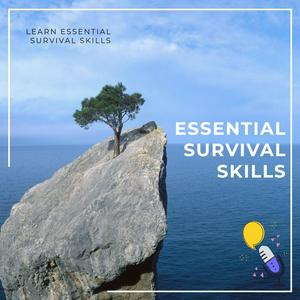57 afleveringen

Shipwreck Survival – Staying Alive When the Ocean Takes Your Vessel
22-12-2025 | 5 Min.
This episode explores how to survive shipwreck situations, where the ocean suddenly becomes both the environment and the enemy. Survival begins with discipline and early preparation, not panic. As a vessel becomes compromised, locating life jackets, flotation devices, rafts, and emergency supplies immediately is critical. Many fatalities occur because people wait too long to act. Listeners learn that abandoning a ship must be done carefully — jumping too early or too late can be fatal. Once in the water, the priority becomes staying afloat and calm, using life vests or any available debris for flotation. Hypothermia is identified as one of the greatest threats, even in moderately cold water, and survivors are advised to adopt heat-conserving positions or huddle together when possible. Dehydration is another major danger. Drinking seawater is fatal, so collecting rainwater and rationing supplies is essential. Sun exposure, reflected by the water’s surface, accelerates exhaustion and injury, making shade and energy conservation vital. The episode also addresses psychological endurance — maintaining routines, structure, and hope to prevent mental collapse during long periods at sea. Visibility is crucial for rescue, with reflective materials and signals significantly increasing survival chances. The core message is clear: the ocean is indifferent, but preparation, patience, and mental resilience keep people alive long enough to be rescued.

Wildfire Survival – Escaping the Fastest Fire on Earth
14-12-2025 | 5 Min.
This episode examines how to survive wildfires, one of the fastest-moving and most destructive natural disasters. Wildfires spread rapidly due to dry vegetation, strong winds, and steep terrain, often outrunning people and vehicles. Survival depends on understanding fire behavior, early awareness, and decisive action. Listeners learn to recognize early warning signs such as smoke smell, falling ash, orange skies, and unusual animal movement. When evacuation orders are issued, immediate departure is critical, as waiting too long often leads to blocked escape routes. Fire moves fastest uphill and through dense vegetation, so survivors are advised to move downhill or laterally toward areas with little fuel, such as roads, rivers, rocky ground, or already burned zones. Smoke inhalation is highlighted as the primary cause of death in wildfires. Covering the mouth and nose, staying low, and avoiding panic are essential to maintain oxygen intake. In extreme cases where escape is impossible, finding fire shadows — areas with minimal fuel — and protecting the airway and body can allow a person to survive the fire’s passage. Urban wildfire risks include embers igniting homes far ahead of flames. Closing windows, removing flammable materials, and sheltering in sturdy buildings may be necessary. After the fire, dangers remain in the form of unstable ground, falling trees, hidden embers, and post-fire flooding or landslides. The core message is clear: wildfires reward speed, awareness, and respect for fire’s behavior. Hesitation and panic are often fatal, but early action saves lives.

Blizzard Survival – Staying Alive When Winter Becomes a Trap
08-12-2025 | 5 Min.
This episode focuses on surviving blizzards, deadly winter storms that combine freezing temperatures, strong winds, and near-zero visibility. Unlike tornadoes or hurricanes, blizzards kill quietly — through confusion, exhaustion, and rapid loss of body heat. Listeners learn that the safest choice during a blizzard is not to travel. Staying indoors is the first line of defense. But if caught outside unexpectedly, survival hinges on immediate action: seek natural windbreaks, build improvised shelters like snow caves, and avoid moving blindly through whiteout conditions, which can disorient even the most experienced survivors. Clothing is emphasized as critical armor. Layering, staying dry, and protecting extremities prevent hypothermia and frostbite. For those trapped in vehicles, the safest strategy is to stay inside, run the engine intermittently, and keep the exhaust pipe clear of snow to avoid carbon monoxide poisoning. Inside homes, blizzards create new dangers: freezing temperatures, power outages, and blocked escape routes. The episode advises isolating one heated room, insulating windows, and conserving warmth safely. Throughout, the psychological strain of isolation and cold is highlighted. Calm, simple actions — staying dry, staying sheltered, and saving energy — are essential to outlasting the storm. The key message: blizzards don’t kill with force, but with the slow, relentless drain of heat and hope. Preparation and calmness are the true survival tools.

Tornado Survival – Staying Alive When the Wind Turns Into a Monster
01-12-2025 | 5 Min.
This episode teaches how to survive one of nature’s most violent phenomena — the tornado, a rapidly forming, unpredictable storm that can destroy entire neighborhoods within minutes. Unlike hurricanes, tornadoes often appear with little warning, making awareness and rapid response essential. Listeners learn that the safest place during a tornado is underground, such as a basement or storm shelter. If no underground option exists, moving to a windowless interior room on the lowest floor — such as a bathroom or hallway — provides the next best protection. Covering oneself with mattresses or blankets helps shield from flying debris, the primary cause of injuries and deaths. The episode stresses that mobile homes are extremely dangerous during tornadoes and should be evacuated early. For those caught outside, the best option is to lie flat in a low-lying area, covering the head and neck. Highway overpasses, often thought to be safe, are actually deadly wind tunnels and should never be used as shelter. In vehicles, attempting to outrun a tornado is risky. If the storm is close, survivors should abandon the car and seek low ground. After the tornado passes, new dangers arise — fallen power lines, gas leaks, unstable structures, and scattered debris — requiring careful movement and attention. Emotionally, tornadoes leave deep psychological impact, but survival depends on calm decisions: checking for injuries, securing shelter, and staying aware of after-threats. The core message: You cannot fight a tornado. You survive it by preparing early, acting fast, and respecting the power of the wind.

Hurricanes and Typhoons – Surviving the Storms of Sea and Sky
24-11-2025 | 5 Min.
This episode explores survival tactics for hurricanes and typhoons, some of the most devastating storms on Earth. It emphasizes that survival begins with early preparation, since these storms form days in advance but can still overwhelm anyone who underestimates their power. Listeners learn that the greatest danger is not the wind but the storm surge, enormous walls of seawater pushed inland. When evacuation orders are issued, leaving immediately is the safest choice. If evacuation isn’t possible, shelter should be taken in a reinforced, windowless interior room, with loose outdoor objects secured to prevent them from becoming deadly projectiles. The episode highlights the deceptive danger of the storm’s eye, a temporary calm that leads many people to venture outside prematurely. When the winds return from the opposite direction, they often strike harder than before. Inside the shelter, staying low, staying away from windows, and preparing for power outages are critical. Flooding remains a major threat during and after the storm. Survivors are warned to avoid walking through moving floodwater, climb to higher levels if necessary, and watch for hidden hazards such as electrical wires or debris. Communication networks often fail, so radios and text messaging become vital tools. Emotionally, hurricanes test mental endurance. The noise, destruction, and uncertainty can overwhelm survivors, but staying calm and focusing on immediate needs helps maintain safety.
Meer Wetenschap podcasts
Trending Wetenschap -podcasts
Over Essential Survival Skills
Luister naar Essential Survival Skills, Focus en vele andere podcasts van over de hele wereld met de radio.net-app

Ontvang de gratis radio.net app
- Zenders en podcasts om te bookmarken
- Streamen via Wi-Fi of Bluetooth
- Ondersteunt Carplay & Android Auto
- Veel andere app-functies
Ontvang de gratis radio.net app
- Zenders en podcasts om te bookmarken
- Streamen via Wi-Fi of Bluetooth
- Ondersteunt Carplay & Android Auto
- Veel andere app-functies


Essential Survival Skills
download de app,
luisteren.






































